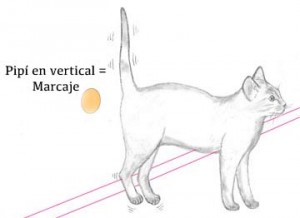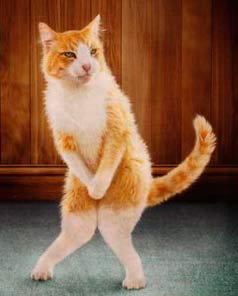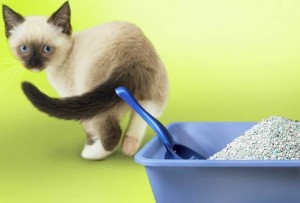If your cat pees outside their tray, it can be due to health, stress, or because he's marking his territory. Discover here the causes and possible solutions to your pussycat urinate elsewhere in the house!
When the cat pees recurring outside their litter tray so the first thing we have to differentiate it if you do as labeling or other causes .
My cat is marking or urinating?
 The way to find out is by looking at how this action occurs. If the cat pee vertical launch(and it usually is accompanied by: Raised tail movement with the legs, tail twitching and jet pee against the wall or other objects) is that it is marking the territory .
The way to find out is by looking at how this action occurs. If the cat pee vertical launch(and it usually is accompanied by: Raised tail movement with the legs, tail twitching and jet pee against the wall or other objects) is that it is marking the territory .
As discussed above, the cat is a territorial animal and a way to narrow your space is to olfactory cues. The cat urine has pheromones that are recognized by the same Pussycat and others of their kind.
Especially the uncast rated male cats have this need to put some ground for calling females. If this is the case your minino, the optimum solution is castration.
Another case marking occurs when the cat feels a strange threat, such as the cat / dog next door or outsiders at home (especially if they are skittish cats).
If threats are from abroad, the ideal is that the litter tray is positioned in a quiet place in the house. If threats are in the home, look for ways to appease their anxiety with, for example, cat pheromones.
Otherwise, if the cat crouches and drops pee horizontally is that you are urinating. And often scratches around the place where he has urinated, as if trying to cover up the pee like he does in his litter tray.
The reasons why the cat urinates on the couch, on the floor, etc. are very different, now we'll see.
Cats can pee out of your inbox by disease
One of the most common causes for the cat urine at home is to have some kind of disease. This can range from a simple cystitis that causes painful urination (in these cases often endure long and pee is plentiful) to stress or depression .
 The infection or irritation of the urinary tract cause the cat cannot or will not go to the litter tray to pee. They often do near the tray itself, as if they had not arrived in time. In these cases it is best to visit the veterinarian to diagnose the specific nuisance and be remedied in time.
The infection or irritation of the urinary tract cause the cat cannot or will not go to the litter tray to pee. They often do near the tray itself, as if they had not arrived in time. In these cases it is best to visit the veterinarian to diagnose the specific nuisance and be remedied in time.
More complicated medical causes are the depression, the anxiety, etc. Such diseases are accompanied by other symptoms such as surveillance and constant search, hyperactivity or, in opposite case, apprehension and uneasiness. It are therefore advisable to visit the vet or a feline therapist to determine the state of the cat and find the solution.
Last but not exactly a disease itself, old age can also cause the cat urine out of your inbox . The oldies cats can lose mobility, be duller, and are often more likely to get infections or other diseases. Therefore, sometimes cats that become too old too wet for other corners of the house.
Overcome litter tray
Often the reason Pussycat not peeing in your sandbox is simpler than anything we've seen: just having problems with the litter tray .
This rejection can occur for several reasons:
-
The litter box is dirty: cats are very camaraderie animals, as you know, and if they find that their litter box is too dirty for your taste may decide not to use it. In these cases not only pee outside, they can also defecate. To avoid this, it is advisable to clean the sand regularly (if clumping litter, removed daily or every other day heaps, and goes filling new sand; if not clumping litter, the complete sand approximately every 2 switches -3 days).
-
The type of sand does not like: There are many types of cat litter, and not all are liked by the Pussycats. The taste changes every cat, but often rejections usually it occur scented sand or odors. Even the detergent you use to clean the case may be grounds for rejection for the Pussycat. The solution is to use mild detergents and arenas with neutral odor, or wood or other natural elements.
-
Sudden change in sand or sandpit: the cat is also a creature of habit, so you can react badly to any changes. And their arena is one of the particularly sensitive, so it is recommended that these variations in type of sand or tray to be made gradually.
-
The sand box itself and its position: sand tray must be large enough for the cat to fit comfortably. Furthermore, it has to be in a place less traveled and quiet, occupying the correct area in the house.
-
Do not want to share their litter tray: in homes that have more than one cat (especially when it has reached a new cat recently) may be a situation that one does not like to share his box. In this case the solution is to have several trays with sand.
Other causes are associated with the sandbox the cat has a bad memory of it (for example if you quarrel being in it, or if we give medication while using it; so avoid these negative situations) or has not learned to use.
The important thing is that we try to determine which case is our cat and act accordingly. Analyzing the compartment surely have some clues as to where to go.
In our case, Conxa are having such problems and are determining if you have any kind of infection that makes you urinate outside the litter box or if it is a problem linked to stress. We hope to find a solution soon.